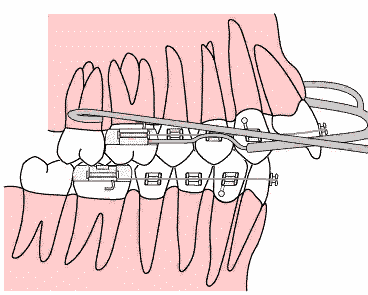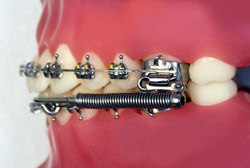Herbst Appliance | Mouthguards | TADs | Pendex Appliance | Headgear/Neckgear | Forsus Appliance | Cemented Expanders | Facemask / Reverse-Pull Headgear
Herbst Appliance
 One of the most common problems orthodontists treat is the discrepancy that occurs when the upper teeth protrude beyond the lower. Ordinarily, when we see a patient with the upper teeth protruding, we tend to think that the upper jaw and teeth are too far forward; but, more often than not, this condition is due to a small lower jaw that is further back than it should be. With these patients, we would like to encourage the lower jaw to catch up in growth, and braces like the Herbst appliance help this happen.
One of the most common problems orthodontists treat is the discrepancy that occurs when the upper teeth protrude beyond the lower. Ordinarily, when we see a patient with the upper teeth protruding, we tend to think that the upper jaw and teeth are too far forward; but, more often than not, this condition is due to a small lower jaw that is further back than it should be. With these patients, we would like to encourage the lower jaw to catch up in growth, and braces like the Herbst appliance help this happen.
Even though the Herbst appliance prevents the lower jaw from moving backward, opening and closing movement still occur easily, and patients do not have any problems learning to chew their food with their lower jaw in this new position.
As with all kinds of braces, patients with Herbst appliances need to be careful about what they eat. For instance, cold foods such as ice slushes, Popsicles and ice will freeze the cement and make the brace loosen. Sticky foods such as caramels, bubble gum and candy suckers will pull the brace away from the teeth. Hard foods like crisp vegetables and hard candies will bend and loosen the Herbst appliance, too. So stay away from these foods during your orthodontic treatment.
Your Herbst appliance will be checked and adjusted at your appointments. If, sometimes between appointments, you develop some sore areas on the inside of your cheeks, please do not try to adjust the appliance yourself. Call for an appointment so that the necessary adjustments can be made.
Wearing a Herbst Appliance
At first, your mouth will feel unusually full and speaking will be awkward. But if you practice reading aloud, your ordinary speech will return quickly. You may also notice more saliva than normal, but this will decrease as you become accustomed to the appliance.
Mouthguards
We are pleased to offer our patients custom-fabricated mouthguards for sports activities. Unlike stock mouthguards, which fit loosely because they are designed to accommodate many possible wearers, our sports mouthguards are tailored to fit your exact dental profile, providing the highest attainable level of comfort and security in a mouthguard.
The first step in fabricating these mouthguards is to take an impression of your teeth. We then use that impression and fabricate the mouthguard using special professional-grade materials. The perfect fit of these custom-fabricated mouthguards ensures that not only will your mouthguards fit comfortably, they will also offer the most protection and will interfere the least with speech or breathing.
TADs
 One of the many important advances in orthodontics has been the development of temporary anchorage devices, or TADs. Made of a bio-compatible titanium alloy, TADs are miniscrew anchors which are inserted into specific places in the mouth to be used as a fixed point from which teeth can move. Before TADs, orthodontists who wanted to move some teeth while keeping others still, or to achieve orthodontic movement in a mouth with missing teeth, had to rely on headgear for their fixed point. But TADs now provide an option for that fixed point that is smaller, more discrete, more efficient and requires significantly less work for the patient.
One of the many important advances in orthodontics has been the development of temporary anchorage devices, or TADs. Made of a bio-compatible titanium alloy, TADs are miniscrew anchors which are inserted into specific places in the mouth to be used as a fixed point from which teeth can move. Before TADs, orthodontists who wanted to move some teeth while keeping others still, or to achieve orthodontic movement in a mouth with missing teeth, had to rely on headgear for their fixed point. But TADs now provide an option for that fixed point that is smaller, more discrete, more efficient and requires significantly less work for the patient.
Temporary anchorage devices may not be recommended for everyone, and in fact, anchorage devices at all may not be needed in all cases. Contact us if you'd like to know more about TADs and how they can potentially prevent you from needing orthodontic headgear.
Pendex Appliance
 The Pendex Appliance is a Pendulum Appliance that uses an expansion screw to widen the upper palate, correcting class II malocclusions and the patient's bite.
The Pendex Appliance is a Pendulum Appliance that uses an expansion screw to widen the upper palate, correcting class II malocclusions and the patient's bite.
The Pendex Appliance consists of a plastic "button" that touches the roof of the mouth. Within this button, there is a keyhole where you are to place the key and turn it according to your orthodontist's instructions. This turning will widen the appliance, thus widening your upper palate. Patients usually wear this appliance for three to six months.
Headgear/Neckgear
This appliance plays a very important role in your treatment by helping correct your overbite along with your braces. In order to be effective, it must be worn as directed. The final orthodontic result and the total treatment time are closely dependent on your cooperation with the headgear. Headgear/Neckgears are generally worn for 6-12 months while in treatment.

Here are a few pointers:
- Make sure you know how to place and remove your headgear. Use a mirror at first to help.
- Start slowly the first week, adding an hour each day until you can comfortably wear the headgear at least five hours of awake time before starting to wear at night. Otherwise, you might end up taking it off in your sleep and not complete the required hours of wear to be effective. "10 minute" rest periods can also help during the first week.
- Sore upper back teeth are common at the start. Take pain medications like Motrin or Tylenol to help. Remember, soreness at the start means teeth are starting to move. The soreness will lessen as teeth become used to the pressure.
- Record your hours on the scorecard supplied. Circumstances may prevent you from reaching your daily total, but try your best. Make up on the weekends, if possible. Keep in mind, skipping one day can cancel three days of progress.
- Bring the headgear to each appointment, so we can make sure it fits and is being worn properly.
Forsus Appliance
 The Forsus appliance is used in order to help move the upper molars back while moving the lower arch forward. Composed of a spring coil rod, the appliance is used while a patient is currently wearing braces. It runs from the upper first molar band down to the lower archwire.
The Forsus appliance is used in order to help move the upper molars back while moving the lower arch forward. Composed of a spring coil rod, the appliance is used while a patient is currently wearing braces. It runs from the upper first molar band down to the lower archwire.
You may notice some discomfort initially, so we recommend a soft food diet for the first few days after the appliance is placed. Regular anti-inflammatory medication may help with any pain, if needed. It is important to keep the appliance clean; you may do this by carefully brushing the coil and other metal pieces of the appliance. Also, we recommend that patients not open their mouths very wide, as the appliance may come apart.
If your Forsus appliance breaks, please contact our office immediately to schedule a repair appointment.
Cemented Expanders
An expander is a special orthodontic appliance that can widen narrow upper jaws and help correct cross bites. It works by gently stretching the upper mid-palatal jaw suture, causing new bone to grow and stabilize the expansion. They are generally worn for approximately 3-4 months.

Here are a few pointers:
- Your mouth may be tender for the first few days. This is normal and should begin to disappear within the first week. Use the wax provided in your start-up bag for any irritation of the cheeks.
- Reading out loud can help with getting used to speaking with the appliance sooner.
- Take small sips of water with each bite during meals and gently swish before swallowing. This will prevent buildup of food on the roof of the mouth. After eating, rinse thoroughly before brushing.
- You will be given a key to turn the expander, usually once a day after dinner. The key inserts into the screw hole located in the middle of the expander and turns from the front of the mouth to the back. Have the patient sit on the floor with their head tipped back in your lap to more easily see the turning. A flashlight can help see in the mouth!
- A space may develop between the front teeth during expansion. This is a good sign; it is only temporary and we will close it after expansion.
- Once expansion is complete, the keyhole is sealed off and the expander is left in place for two months before it is removed. This is done in order to allow the stabilizing bone to mature in the suture.
Facemask / Reverse-Pull Headgear
 Often referred to as reverse-pull headgear, the protraction face mask is a removable appliance for patients where the upper jaw is not growing fast enough, resulting in a crossbite or underbite. The device consists of a metal bar attached to pads on the forehead and chin with rubber bands hooked to the face mask and the upper braces to gradually move the upper jaw forward. Patient compliance is extremely important as the face mask must be worn a set number of hours per day or more to obtain the desired results. The face mask device is generally worn for six to 12 months.
Often referred to as reverse-pull headgear, the protraction face mask is a removable appliance for patients where the upper jaw is not growing fast enough, resulting in a crossbite or underbite. The device consists of a metal bar attached to pads on the forehead and chin with rubber bands hooked to the face mask and the upper braces to gradually move the upper jaw forward. Patient compliance is extremely important as the face mask must be worn a set number of hours per day or more to obtain the desired results. The face mask device is generally worn for six to 12 months.

